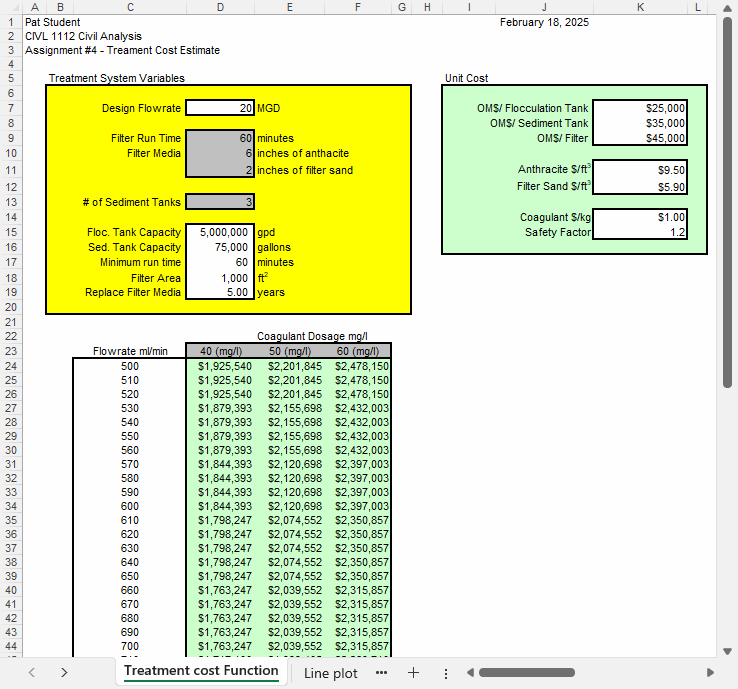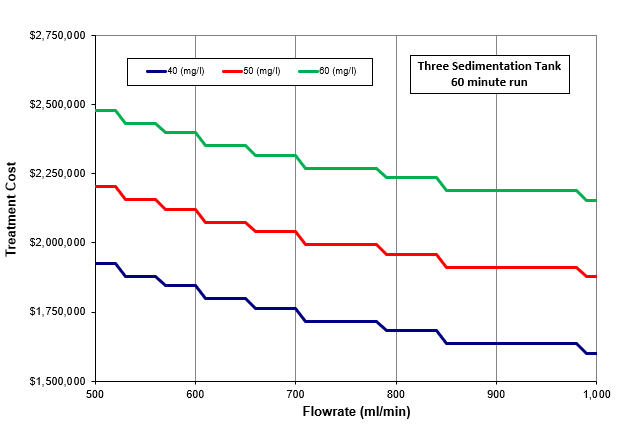|
"The more you read, the more you know. The more you know, the
more places you will go." - Dr. Seuss
Objective
This assignment aims to continue to improve your spreadsheet skills and
experiment with visualization of large data sets and continue to develop a
section of your Project #1 report.
You must hand in the cover
sheet for the assignment, printouts of your
spreadsheets for Parts 1 and 2, and your
calculations for Part 3. Also, submit your
spreadsheets for Parts 1 and 2 to Canvas. You
must follow the Excel format.
Part 1: Use WORD and the equation editor to develop a document that describes how the
capital and operations costs are computed for our prototype water treatment
system. Click on the following link to
download
a sample version of the document.
Part 2: Use Excel to create a spreadsheet where you can explore the relationship
between system flowrate (ml/min) and coagulant dosage (mg/l) as a function of
cost ($). Rewrite your treatment cost spreadsheet to perform the entire cost
calculation in one cell and develop a table of cost values for a range of
coagulant dosages and system flowrates. Develop a spreadsheet
using the format shown below. Use the same values
shown in the spreadsheet for the variation of coagulant dosages and flowrates.
Hint: all green-shaded cells
contain formulas to compute the cost values. Click
here for a blank template of the following water treatment cost spreadsheet. Click
here for a form of NF factored our of filtration cost function.

Use the data developed in this spreadsheet to plot the variation of treatment
cost as a function of flowrate and coagulant dosage. Your plot should have the
following format.

Part 3: Use the
ACI method for concrete mix
design to proportion a 1 yd.3 of concrete. Compute the weight of
each mix component by hand to meet the following specifications:
This concrete is required for an interior
column. The 28-day compressive strength should be 6,000 psi. The slump should be between
1
and 2 in. The maximum aggregate size should not exceed 1 in. The properties of the
materials are as follows:
- Cement: Type I, specific gravity = 3.15
- Coarse
Aggregate: Bulk specific gravity (SSD) = 2.65
absorption capacity = 0.5%
dry-rodded unit weight = 96 lb./ft.3
surface moisture = 0.5%
- Fine
Aggregate: Bulk specific gravity (SSD) = 2.60
absorption capacity = 1.1%
fineness modulus = 2.70
surface moisture = 1%
Follow the
homework format
given in class and report the weight of cement, water, coarse aggregate, and
fine aggregate required per cubic yard for this application. If we
were to mix this concrete in the lab using the yellow mixer (about 1 ft3 in volume), what would be the required weight of cement, water, coarse
aggregate, and fine aggregate?
Part 4. Read Chapters 7 and 8 in "A Mind for
Numbers" by Barbara Oakley.
A web page describing the CIVL 1112
homework
policy is available. Please read it before you turn in this assignment.
Cover sheet for homework
This website was originally
developed by
Charles Camp for
CIVL
1112.
This site is maintained by the
Department of Civil Engineering
at the University of Memphis.
Your comments and questions are welcomed.
|





